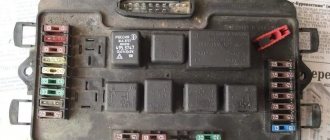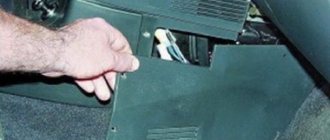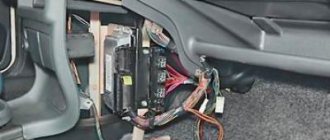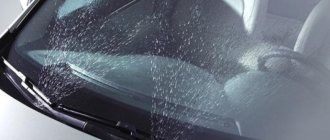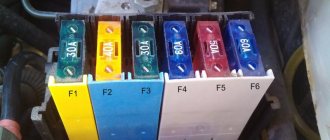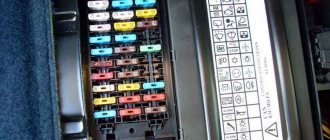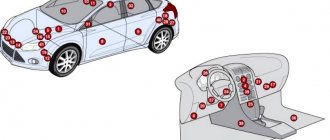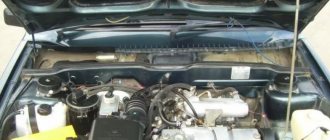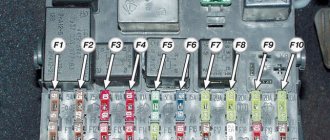The fuse for the VAZ 2114 fog lights protects the vehicle's electrical wiring from fire when the permissible load is exceeded or a short circuit occurs. Systematic burnout of the fusible element indicates the presence of faults in the circuit. To determine where the fuse for the fog lights is located on a VAZ 2114, you need to open the cover of the mounting block. The manufacturer applied designations on its back side.
Depending on the year of manufacture of the vehicle, the location of the fuses in the mounting block differs.
New sample block
On the VAZ 2114 car, the manufacturer simultaneously installed two fuses designed to protect the fog lamp circuits. The PTF fuse on the VAZ 2114, which protects the left headlight, is designated F 8 and is located eighth from top to bottom in the left column of the mounting block. The electrical circuit for switching on the right fog lamp is protected by an element designated F 9 . It is installed 9th in the left column from top to bottom.
Both fuses are rated at 7.5 amps. In case of replacement, you should select a fuse for the fog lights of the VAZ 2114, designed specifically for this load. Exceeding this parameter may lead to a fire in the electrical wiring. Installing an element designed for a lower load will lead to its rapid burnout.
Decoding fuses and relays
In many cars, the covers of the fuse and relay boxes contain their descriptions, often in English. For those who have difficulty with this, we have prepared a detailed explanation of the symbols (translation into Russian). The first table contains the most common ones, followed by a more detailed list.
Circuit example
Table with designation
| A/C | Air conditioner |
| ABS | ABS |
| FLT | Generator |
| ALT-S | Generator |
| F.V. | Engine switch |
| DEF | Window heating |
| DOME | Interior lighting |
| DOOR, ROOM | Door |
| ECU | Engine control (control) module |
| EDU | Injection control |
| EFI | Electronic injection control system in TOYOTA vehicles |
| ENG MAIN | Main engine |
| FAN | Fan |
| FOG | Fog |
| Fr | Front |
| R-TAIL | Tail lights |
| GAUGE | Dashboard, speedometer |
| HAZARD | Alarms |
| HAZ-TRN | Emergency - turns. |
| HEAD | Headlights |
| HEAD-LH | Left headlights |
| HEAD-RH | Right headlights |
| HORN | Sound signal |
| HTR | Heater |
| I/UP | Idling |
| I.G. | Ignition |
| IGN | Ignition |
| MAIN | Main |
| P/W | Radio |
| POWER | Nutrition |
| RAD | Radio |
| Rr | Rear |
| S.I.G. | Light a cigarette |
| SPARE | Spare |
| ST | Starter |
| STOP | Stop signal |
| TAIL | Lights / Dimensions |
| TURN | Turn signals |
| WASH | Windshield washer |
| WIP | Wiper |
| WIPER | Wiper |
The cigarette lighter fuse is usually designated as C-LIGHT, CIGARE, POWER OUTLET.
Full description
4F (4 floor manual transmission) - 4-speed manual transmission 4A/T - 4-speed automatic transmission 5F (5 floor manual transmission) - 5-speed manual transmission ABS - anti-lock braking system - anti-lock braking system AC (A/C) - air conditioner - air conditioner ACL (air cleaner) - air purifier ANT (antenna) - antenna AR (air bag) - airbag AT - automatic transmission - automatic transmission AW (A/W) - alloy wheels - alloy wheels CD - compact disk player - CD player CL (C/L) - central locking - central locking CS - cassette stereo - radio tape recorder D - diesel - diesel DM (door mirror) - door mirror DR - door - door (for example, 5DR - five-door car, 3DR — three-door car) EW (E/W) — electric windows — electric windows F5 (floor manual 5 speed) — 5-speed manual transmission FL — fuel — fuel FL (F/L) — fog lamps — fog lights FS (F/S ) — front spoiler — front spoiler G — gasoline — gasoline GG (G/G) — grille guard — arc H/B — hatch back — hatchback KE (K/E) — keyless entry — opening doors without keys LB — log book — technical passport (service book) MT - manual transmission - manual transmission P/U - pick up - pickup truck PM (P/M) - power mirror - electrically adjustable mirrors PPS (progressive power steering) - power steering system PS (P/S) — power steering — power steering PW (P/W) — power window — power windows RC (R/C) — radio/cassette — radio RS (R/S) — rear spoiler — rear spoiler RW (R/W) — rear wiper — rear wiper, “broom” S/D — sedan — sedan S/H — seat heater — heated seats S/P — sports — sports car SKR — skylite roof — “glass” roof (many hatches, “aquarium”) SR (S/R) — sun roof — sunroof SS (S/S) — side spoiler — side spoiler ST — stereo — stereo STR — stereo cassette player & radio — radio tape recorder T/R = truck — truck TM (T/M) — transmission - transmission TR - transmission - transmission W/G = wagon - station wagon WS (wheel steer) - steered wheels YR - year - year
A - ampere(s) - ampere ABS - anti-lock braking system A/C (air conditioner) - air conditioner ACC - ignition switch position (windshield wiper, radio, cigarette lighter on) ACC (accessory) - additional power ACCEL (accelerator) - gas pedal ACL (air cleaner) - air cleaner ADJ -ADJUST - adjustment A/F (air fuel ratio) - composition of the fuel-air mixture AIR FLOW METER - air flow sensor ALB - anti-lock braking system ALT (alternator) - generator ALT (altitude) - altitude AM 1 - power supply to the first group of contacts of the ignition switch AM 2 - power supply to the second group of contacts of the ignition switch AMP - see A ANT (antenna) - antenna APS - rewind mode "automatic pause search" in the tape recorder ASM (assembly) - A/T assembly - automatic transmission ATDC - after top dead center ATF (automatic transmission fluid) - automatic transmission fluid ALTO (automatic) - automatic B (battery) - battery BACK UP - reverse BAND - range (at the radio) BARO (barometric pressure) - atmospheric pressure BAT - see B BEAM - high beam BELT - belt BLOWER MOTOR - interior heater motor (aka air conditioner) BOOST - vacuum value in the intake manifold BRAKE - brake BREAKER - thermal breaker (multiple action fuse) BTDS - to top dead center C - see CONTROL CAC (charge air coder) - intake air cooler CAM-CAMSHAFT - camshaft CC - cubic centimeter CDS FAN (condenser fan motor) - fan motor, condenser cooling (air conditioner radiator) CHECK - check CHECK CONNECTOR - test connector CHG - CHARGE - charging CHOKE - air damper CI - central injection CIG FUSE - cigarette lighter fuse SKR (crankshaft position) - crankshaft position CMN (cold mixture heater) - fuel mixture heater CMR (camshaft position) - camshaft position CO (carbon monoxide) - oxide carbon COLD - cold CONTROL - control CRANK (crankshaft) - crankshaft D - DRIVE - movement DEF (defogger) - defroster, heated rear (front) glass DI (distributor ignition) - distribute ignition DITRIBUTOR - distributor DOHC (double overhead camshaft) - double camshaft in the head of the block DOME - instrument panel, interior DOOR CONTROL - door control DOWN - down DTS (diagnostic trouble code) - self-diagnosis codes DTM (diagnostic tast mode) - diagnostic mode E - END - end (of fuel) E - EARTH - " ground" (housing) EAI - air supply to the exhaust system ЕВСМ (electronic brake control module) - electronic brake control unit ECC (emission control computer) - engine emissions (evaporation) control unit ECI - electronic central injection (also CI) ECM (engine control module) - see ECV ECON - ECONOMY - economical (operating mode) ECT (electronic control transmission) - electronic transmission control ECT (engine coolant temperature) - engine temperature ECU (electric control unit) - electric control unit EFI - electronic fuel injection EGR (exhaust gas i ^circulation) - exhaust gas return ENG - ENGINE - engine EPS - electronic shock absorber control EST-S - see ECT EVAP (evaporative) - vapor extraction system (from the gas tank) F (front) - in front of F (full ) — full (fuel level) F (or FF). FORWARD - forward FAST - fast FAN MOTOR - fan motor FAN I/UP RELAY - relay for increasing idle speed when the fan is turned on FC (FCUT) - FUEL CUT - fuel cut-off FL (fusible link) - safety insert FLUID - liquid FOG LIGHTS - fog headlights FP - see FUEL PAMP FREE - free FUEL - fuel FUEL PAMP - fuel pump FUSE - fuse FUSIBLE LINK - safety line FWD (front wheel drive) - front wheel drive GAUGE - GLOG sensor PLUG - glow plug H (hard) - hard ( suspension mode) H (hocr) - hour H or Hi (high) - high (revolutions), high (gear, temperature) HAS (high altitude compensation) - atmospheric pressure compensation system HAI (hot air system) - hot air supply system intake manifold (when the engine is running in severe frost) HAZ (hazard) - hazard warning light HEAD LN - left headlight HEAD RH - right headlight HEAD RH LWR - right low beam headlight HEAD RH UPR - right high beam headlight HORN - signal NOT - hot HTR (heater) - heater IAC (idle air control) - idle air control IDL (idle) - idle IDL/UP - see I/UP IG (IGN) - igniter - switch IG (IGN) - ignition - ignition IGNITION COIL - ignition coil ON - ignition integral assemble - integral ignition assembly INJECTOR - injector INT - interval - interval I/UP - idle up - increase idle speed L (low) - low (revolutions), low (gear, temperature) L (left) - left (mirror, position) LEVEL - level LF (left front) - left front LH (left hand) - left hand LO - see L LOCK - lock LR (left rear) - left rear LS (left side) - left side M (medium) - middle M (memory) - memory M (minute) - minute M see MANU MAP (mass air flow) - air volume meter MAIN RELAY - main relay MAN - see MANU MANU - manual (control , adjustment) MS (mixture control) - mixture control MIL (malfunction indicator lamp) - malfunction indicator lamp ("check") MIRROR - rear view mirror MODE - mode selection MPI - multipoint injection M/T - manual transmission N - neutral - neutral (position) N - normal - normal (condition) O/D - over drive - overdrive 2 WAY 0/D - automatic shutdown of overdrive OHC - (overhead camshaft) - camshaft in the cylinder head OFF - turned off OIL - oil ON - on OX SENSOR - oxygen sensor P - PARKING - parking POWER CB - power control block - power control unit (usually a control unit for doors and windows) PCV (positive crancase ventilation) - crankcase ventilation system PPS (progressive power steering) - system steering force control PRE HEATING TIMER - preheating time relay (usually glow plugs) PUMP - pump PULL - pull PUSH - press PWR (power) - power mode QUICK - fast R (return) - return, back R (right) - right (mirror, position) RDI FAN (radiator fan motor) - engine cooling radiator fan motor REAR DOOR - rear door REAR WASHER MOTOR - rear window washer motor REAR WINDOW DEFOGGER - rear window defroster RELAY - RESET relay - installation REV (reversal) - change directions RICH - rich (mixture) RPM - revolutions per minute RR - REAR - rear (for example, RRDEF - rear defroster) RTR MOTOR - retract motor - motor for opening and closing headlights S (soft) - soft SAE (Society of Automotive Engineers) - Society of Automotive Engineers SEAT HTR - seat heater - heated seats SEEK - search SELECT - selection (mode) SENSOR - sensor SET - setting SLOW - slow SOHC (single overhead camshaft) - one camshaft in the head of the block SPD - SPEED - speed SPORT (S) - sport (mode) ST - STARTER - starter SUN ROOF - sunroof S/W (switch) - TAIL switch - parking lights (lights) TV (throttle body) - throttle body TEMS (Toyota electronic modolated suspension) - see. EPS TDS (top dead center) - top dead center TEMP (temperature) - temperature THROTTLE POSITION SENSOR - throttle position sensor THA - temperature heat air - air temperature TGH - exhaust gas temperature THW - temperature heat water - water temperature ("Antifreeze" ) TRN - TURN - turn TURN RELAY - turn relay UP - up VACUUM SENSOR - vacuum sensor VALVE - valve VSV (vacum solenoid valve) - solenoid valve on the vacuum line WARMER - heater W (warning) - warning WASHER - washer WATER - water WD (wheel drive) - driving wheels WIPER - windshield wiper WINDOW glass WS (wheel steer) - steered wheels 4WD (four wheel drive) - all-wheel drive 4A/T - four-speed automatic transmission
Weren't we looking for something? Write in the comments.
Old style mounting block
Older car models have a different type of mounting block. The fuse for VAZ 2114 fog lights is also installed separately for each headlight. In the old-style block, the element responsible for the right fog is designated F 9 , and for the left one - F 8 .
The maximum permissible load for each element is 7.5 amperes.
F9 and F8 are located first and second from left to right in the bottom row.
Useful : Fog lights don't light up (7 reasons)
Description of the relay in the cabin unit
| № | Name | what does it include |
| K1 | Cooling fan relay | Cooling fan motor |
| K2 | Power window relay | Power window motors |
| short circuit | Starter relay | Starter traction relay |
| K4 | Additional relay | Control circuits: relay for low and high beam headlights, daytime running lights, rear window defogger, heater fan motor, windshield wiper and washer |
| K5 | Relay-breaker for direction indicators and hazard warning lights | Turn signal lamps in headlights, tail lights and side turn signals |
| K6 | Windshield wiper relay | Windshield wiper motor |
| K7 | High beam relay | Block headlights (high beam) |
| K8 | Horn relay | Sound signal |
| K9 | Low beam relay | Block headlights (low beam) |
| K10 | Heated rear window relay | Rear window heating element |
| K11 | Main relay | Engine management system |
| K12 | Fuel pump relay | Fuel pump (gasoline pump) |
Where is the PTF relay located?
On VAZ 2114 cars there are no front fog lights by default. Installation of PTF is an additional option. On older versions, the fog light relay is installed in the engine compartment. For easy access to it, it is necessary to remove the battery. On modern models, the fog light relay is installed in the passenger compartment. It is located on the driver's side under the steering column.
Unexpected reasons for non-working PTFs on the VAZ-2110
The most common cause is a blown fuse.
But we will return to it later. There is still a lot that is still unknown in the design of foglights, relays, switches and lamps. For example, a possible reason for the failure of fog lights could be a completely unexpected breakdown.
First of all, we check the bulbs themselves; you can get to the left one through the hood.
On some versions of the VAZ-2110, a PTF from the Avtosvet plant (Kirzhach) was installed with a socket for the H1 lamp. Stock lamps are not the best quality and they do not like sudden changes in temperature.
Useful video
You can glean additional interesting information from the video below:
If all of the above reasons have been checked, and none of them have been identified, then the problem is in the wiring itself. In this case, you should ring all the wires used in the fog lamp connection circuit, and also check the correctness of the connection itself.
This can be done using the diagram given at the beginning. In this case, special attention should be paid to the correct connection (to the required connectors) of the button and relay.
Replacing the VAZ 2114 fuse
Often, car electrical breakdowns are caused by a blown fuse. Before checking components, contacts, and wiring for damage, the fuses are always checked first. If the integrity of the element is compromised, it simply needs to be replaced.
First, we determine which device is faulty and where its fuse is located. When further troubleshooting, you must disconnect the “—” terminal of the battery. Open the hood, remove the cover of the VAZ 2114 mounting block, take tweezers and pull out the fuse that is supposedly blown. Do not use a metal screwdriver or other tools to work on fuses.
There are external signs by which you can visually determine whether it has burned out or not. But the most reliable check is with the help of a tester. We set the multimeter to the continuity mode and apply the probes to the contacts of the electrical circuit. If the product is working properly, the tester will show a resistance of 0 and emit a sound signal.
If the fuse element is destroyed, the fuse must be replaced. The cost of the product varies between 150–350 rubles, depending on the type.
- Electrical equipment
- Engine
- Brake system
- Other
- Steering
- Transmission
- Suspension
- Tuning
- VAZ 2110
- Other
- Engine
- Steering
- Electrical equipment
- Transmission
- Brake system
- Suspension
- Tuning
- VAZ 2114
- Electrical equipment
- Engine
- Brake system
- Other
- Steering
- Transmission
- Suspension
- Tuning
- Lada Priora
- Steering
- Engine
- Suspension
- Electrical equipment
- Tuning
- Brake system
- Transmission
- Video publications
- VAZ tuning photo stream
- Operation and repair manuals
Fuse box for VAZ 2114 Lada
An important part of the Lada's electrical circuit is the fuses. Without them, equipment would often fail. Each machine has a separate block for protective elements. In order to timely identify faults in the electrical circuit of this car, you first need to know what the VAZ 2114 fuse box is.
Most of the protective elements are located under the hood, with another part located to the right of the center instrument console. There are more than twenty fuses in Lada. It is necessary to understand what function, connection diagram and characteristics each of them has.
Why replace the side light fuse on a Ford Focus?
. So let's start our content page about the location of the side light fuse of your Ford Focus thanks to its modification. You may be under the impression that you have a blown fuse, but you are not sure. If you can no longer use your car's night lights, it is possible that a fuse is the culprit. It is important to know that the fuse acts as a safety unit to prevent overvoltage on your Ford Focus . This will be a resistor, a thread, more or less thick, that will allow a certain tension to be completed and which will break if the tension is too strong. Hence the fact that for them to be transparent, you can check them and make sure that the thread is not damaged by a simple visual inspection. Typically, you want to replace the Ford Focus parking light fuse if they no longer work without explanation . If your battery is working fine, the problem may be with the fuse.
The VAZ 2114 has two blocks
The electrical circuit of the VAZ 2114 fuses is divided into two mounting blocks:
The main set of instruments is mounted under the hood on the left side (when viewed from the driver's position). The plastic cover is held on by latches, with the help of which it can be easily snapped off and can then be removed. The inside of this cover is equipped with a layout diagram that shows the rated current for each element. A detailed electrical diagram of the mounting block with the order of connecting contacts to the plugs is shown in the Lada 2114 instruction manual.
It is not allowed to insert a fuse whose amperage exceeds the permissible values in the circuit. This puts electrical equipment at risk. There are tweezers in the upper right corner of the mounting block. The design of this unit provides seventeen working fuses (which are schematically named F1-F16) and four backup protective elements (F17-F20): gray (2 A), pink (4 A), yellow (20 A); green (30 A).
The second mounting block of the VAZ 2114 is located in the cabin under the glove compartment, to the right of the central instrument console. You can get to it by moving the passenger seat all the way back. This mounting block includes a protective element for the fuel pump (with a rated current of 15 A). The remaining ES are designed to protect the fan relay, speed sensor (built into the gearbox), and mass air flow sensor.
The rated amperage of the element is 7.5 A. An element with the same rated current is provided for the ignition unit and ECU.

